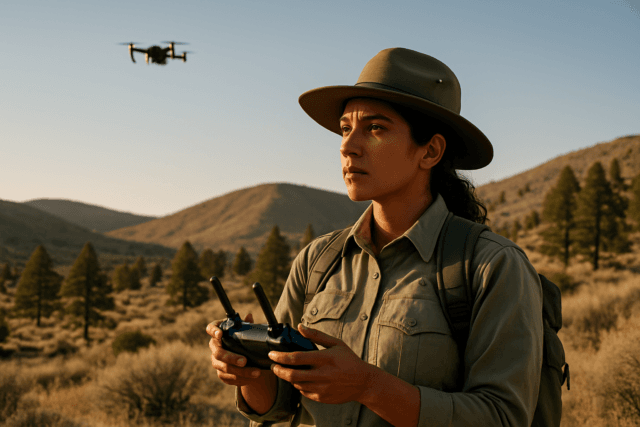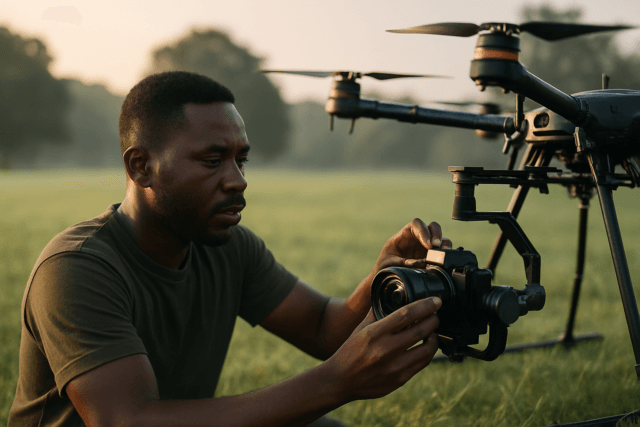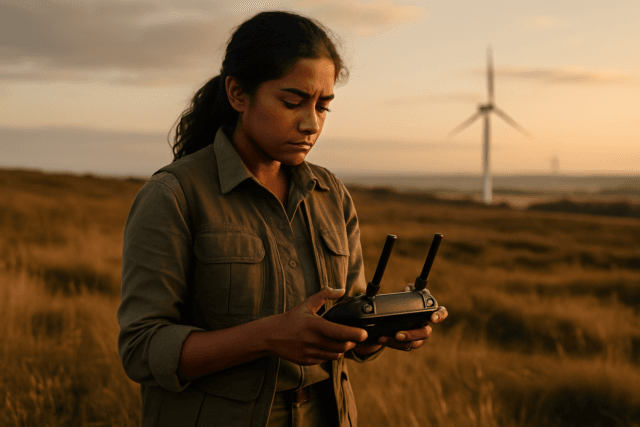In an era where global food demand is steadily rising and agricultural landscapes face increasing pressures from climate change and resource scarcity, farmers are constantly seeking innovative solutions to optimize productivity and sustainability. Traditional land surveying methods, often labor-intensive and time-consuming, are giving way to a powerful technological advancement: agricultural drones. These unmanned aerial vehicles (UAVs) are rapidly becoming indispensable tools, offering unparalleled insights into farm conditions and enabling a new era of precision agriculture and environmental monitoring.
The Rise of Drone Technology in Agriculture
The integration of drones into agricultural practices has ushered in a new era of smart farming, providing farmers with real-time, high-resolution data that empowers data-driven decision-making. What once took days of walking fields to identify issues can now be accomplished in minutes from the sky, offering a comprehensive overview that improves yields and reduces waste.
What is Agricultural Land Surveying with Drones?
Agricultural land surveying with drones involves using UAVs equipped with advanced sensors and cameras to collect detailed aerial data about farm fields. This data is then processed to create highly accurate maps and models of the terrain, crop health, and environmental conditions. Unlike satellite imagery, which can be costly and less affected by clouds, drones offer greater proximity and therefore superior image resolution, providing more up-to-date and granular information.
Key Benefits of Drone Surveying in Agriculture
The adoption of drone technology brings a multitude of advantages over conventional surveying techniques, significantly enhancing efficiency, cost-effectiveness, and data quality in farming operations.
Time Efficiency and Cost Reduction
Drones can survey vast areas in a fraction of the time required by ground-based methods, allowing farmers to quickly monitor large parcels of land. This rapid data collection translates into reduced labor and equipment needs, leading to significant cost savings.
Improved Accuracy and Data Richness
Equipped with high-resolution sensors and advanced data processing techniques, drones yield highly accurate results, often achieving centimeter-level precision, especially with RTK/PPK integration. The variety of sensors available for drones provides a wealth of data types, from visual imagery to thermal and multispectral information, offering comprehensive insights that help farmers make better decisions.
Enhanced Crop Monitoring and Health Assessment
Drones equipped with specialized cameras, such as multispectral and thermal sensors, can detect early signs of pest infestations, diseases, or nutrient deficiencies before they are visible to the human eye. This early detection allows for prompt, targeted interventions, safeguarding crop health and boosting yields.
Precision Resource Management
Drone-collected data enables precision agriculture practices by providing detailed information on soil conditions, moisture levels, and plant density. This allows farmers to apply fertilizers, pesticides, and water exactly where needed, reducing chemical usage, minimizing environmental impact, and conserving resources.
Safety and Environmental Advantages
Drones can access hazardous or hard-to-reach areas without putting surveyors at risk. Environmentally, drones consume less energy than traditional surveying vehicles, reduce overall emissions, and cause minimal disturbance to sensitive habitats.
Types of Data Collected by Agricultural Drones
Agricultural drones are sophisticated platforms capable of collecting diverse types of data, each offering unique insights for optimized farm management.
RGB Imagery
Standard color images captured by high-resolution RGB cameras are useful for visual inspections, spotting physical damage, gaps in crops, or tracking general growth patterns. They provide a visual record of progress and can identify obvious problems.
Multispectral and Hyperspectral Data
These sensors measure light beyond human vision, including wavelengths like near-infrared, which plants reflect differently based on their health. This data is crucial for creating vegetation indices such as Normalized Difference Vegetation Index (NDVI), Normalized Difference Red Edge (NDRE), and others, which show plant vitality and stress levels.
Thermal Data
Thermal cameras detect temperature differences in soil and plants, which can indicate irrigation issues, soil moisture levels, or heat stress in crops.
LiDAR and 3D Mapping Systems
LiDAR (Light Detection and Ranging) systems use laser beams to create detailed 3D models of the terrain. This is invaluable for topographic mapping, assessing elevation changes, analyzing drainage patterns, and calculating volumes for earthworks.
Drone Technology for Precision Agriculture
The effectiveness of drone surveying hinges on the sophisticated technology they employ, from the aerial platforms themselves to the sensors and software that transform raw data into actionable intelligence.
Types of UAVs
- Fixed-wing Drones: Designed to cover extensive areas, these drones can operate at higher altitudes, making them efficacious for large-scale mapping and surveillance missions over vast agricultural zones.
- Multirotor Drones (e.g., Quadcopters): Offering enhanced maneuverability and hovering capabilities, multirotor drones are optimal for applications requiring high precision, such as targeted spraying and detailed crop inspection in challenging terrain.
Advanced Sensors and Payloads
Drones are equipped with a range of payloads including high-resolution RGB cameras, multispectral and hyperspectral sensors, thermal cameras, and LiDAR systems. GPS and RTK (Real-Time Kinematic) or PPK (Post-Processed Kinematic) capabilities ensure centimeter-level precision in data collection.
Data Processing Software
Specialized photogrammetry software (e.g., Pix4D, DroneDeploy, DJI Terra) is used to stitch together overlapping images and convert raw data into various outputs. These outputs include orthomosaic maps (single, high-resolution images), digital surface models (DSMs), digital terrain models (DTMs), 3D point clouds, and contour maps.
AI and Machine Learning Integration
Increasingly, AI and machine learning are integrated into drone systems to enhance autonomy, interpret environmental data, and perform advanced imaging analysis, allowing for real-time data processing and automated decision-making.
The Drone Surveying Workflow
A typical drone surveying workflow follows a structured approach to ensure accurate and actionable data is collected and processed.
- Planning the Mission: This involves defining the project area, selecting the appropriate drone and sensor, choosing flight altitude and overlap settings (typically 70-80%), and checking airspace regulations and weather conditions.
- Data Acquisition (Flight Execution): The drone follows a pre-programmed flight path, capturing georeferenced imagery and sensor data. Ground Control Points (GCPs) may be deployed to improve data accuracy.
- Data Processing: Collected data is imported into specialized software that processes and converts it into orthophotos, elevation models, 3D models, and other geospatial products.
- Analysis and Reporting: Surveyors analyze the processed data, verify its accuracy, and compile reports. Outputs can be integrated with GIS (Geographic Information System) and CAD (Computer-Aided Design) software for further analysis and to create action plans. This may involve identifying problem zones and adjusting nutrient levels, irrigation, or spraying applications.
Challenges and Considerations
While the benefits are substantial, integrating drones into agricultural land surveying comes with its own set of challenges.
Regulatory Hurdles
Complex and varying regulations regarding drone usage, airspace permissions, and operator certifications across different regions can create confusion and delays. Staying informed and engaging with local aviation authorities is crucial.
High Initial Investment
The cost of acquiring high-end drones with advanced sensors, software, and training can be a significant barrier, especially for small to medium-sized farms. However, costs are decreasing, and outsourcing to drone service providers can be a viable alternative.
Technical Expertise
Operating drones and analyzing the voluminous data they collect requires specialized skills and technical expertise. Training and professional support are essential for effective implementation.
Environmental and Operational Limitations
Drones are weather-dependent and cannot fly during heavy rain, strong winds, or fog, limiting their use in certain conditions. Battery life and flight range can also restrict large-scale operations, though advancements in battery technology are addressing this.
Data Management and Interpretation
The sheer volume of data collected by drones requires robust systems for management, processing, and interpretation. Turning raw aerial data into actionable insights demands effective post-processing tools and analytical skills.
The Future of Drones in Agricultural Land Surveying
The future of agricultural drones is marked by continued innovation and broader adoption. Experts anticipate increased automation, with fully automated drone fleets potentially managing entire farms. Improved data analytics, enhanced connectivity, and deeper integration with IoT (Internet of Things) devices and AI will provide farmers with even more real-time, holistic insights for smart farm management. Drones will continue to play a crucial role in sustainable farming by enabling precise resource application, reducing chemical use, minimizing water waste, and improving overall land management, ultimately contributing to greater productivity, yield, and resilience against climate change. As technology advances and costs decrease, drones are poised to become an increasingly ubiquitous and essential component of modern agriculture, benefiting farms of all scales.





